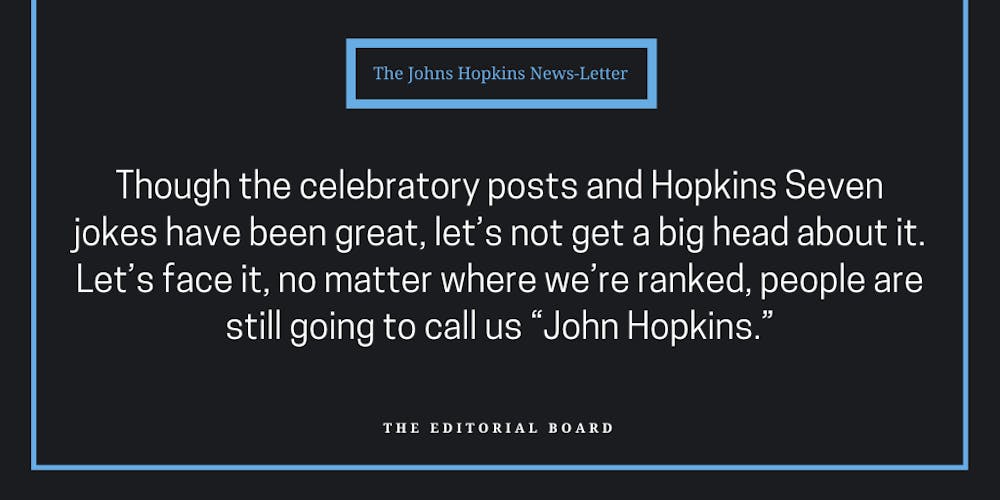We’ve heard a lot of Hopkins Seven jokes over the past week, and they have nothing to do with D-level.
The recently released 2022-2023 U.S. News & World Report college rankings place Hopkins at seventh among national universities — a jump from last year’s ninth. The annual rankings always spark conversation around campus. Over the last decade, Hopkins has gradually climbed to the top 10 and is continuing to rise through the ranks.
We understand Blue Jays’ excitement over number seven — Hopkins hasn’t been ranked so highly since 1999. But we wonder what this ranking even means. Is Hopkins now better than Duke but still worse than Harvard? Was Hopkins substantially worse when it ranked 14th in 1998 than when it ranked seventh in 1999?
Regardless, some schools have gone to drastic lengths to preserve their spot at the top. Columbia University was absent from the top of U.S News rankings this year, dropping to 18th after it was revealed the school previously reported misleading and inaccurate data.
In a statement last Friday, Columbia admitted to misrepresenting the data in question, showing just how far university administrations are willing to go to protect or advance their position within the national ranking.
Yet even if the data is reliable, the metrics used to determine the rankings aren’t as comprehensive as they may seem. For example, in the U.S. News methodology, the social mobility category, weighted at 5%, is based on the graduation rates of Pell Grant recipients. Those rates are important, no doubt, but we wonder whether that data alone can accurately capture the nebulous concept of social mobility at a university.
The ranking itself may also incentivize the wrong behaviors when it relies on metrics such as standardized test scores and alumni contributions. Boosting average SATs and donations during Alumni Weekend doesn’t necessarily make a school “better” — instead, standardized testing disadvantages low-income and minority students in the admissions process, and the emphasis on alumni contributions prioritizes students and faculty in more lucrative fields. Other factors that prospective students might value, like public safety and first-year experience, are left out of the U.S. News ranking criteria altogether.
While U.S. News may try to reflect changes at universities across the country, whether that be innovative research or smaller class sizes, their annual list is simply preserving the status quo. To calculate undergraduate academic reputation, weighted at a cool 20%, top academics such as provosts and deans rate the quality of peer institutions. Essentially, this means that one-fifth of a university’s ranking — which affects its reputation — is determined by its reputation. Given this self-perpetuating cycle, it’s easy to see why Harvard and Princeton have been jockeying for first place for years.
At the end of the day, Hopkins is a business like every other university, and rankings are just another selling point. Universities with more resources are ranked higher, which attracts more high-achieving students, who may have more money and resources to offer. These resources can then be funneled into further bolstering a university’s rankings, keeping them at the top. Ultimately, this attempt to objectively rank colleges just creates a positive feedback loop that reinforces existing inequities.
For high schoolers currently crafting their list of dream schools, we recommend you consider more than rankings when doing your research. Choosing a college is an incredibly personal decision, and U.S. News shouldn’t be the one to make it. Hopkins could be a great fit for you — but it won’t be just because it’s number seven.
And Blue Jays, though the celebratory posts and Hopkins Seven jokes have been great, let’s not get a big head about it. Let’s face it, no matter where we’re ranked, people are still going to call us “John Hopkins.”





